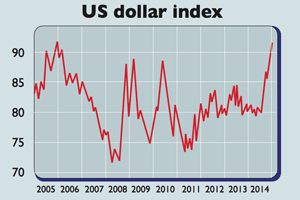
In the forex market the first few days of 2015 have looked just like 2014: “positive US sentiment fuelling US dollar gains”, says Jeremy Stretch of CIBC.
The US dollar index, which tracks the currency against a basket of currencies of America’s major trading partners, has hit its highest level since 2006. Last year it rose by 13%, its best year since 2005. The dollar also reached a nine-year high against the euro.
This bull market looks far from over. The US economy looks the strongest of all the developed economies and is expected to grow at its fastest pace in a decade over the next two years. The US consumer, who accounts for around 70% of GDP, “is in good shape and is going to hold up this recovery”, says IHS Global Insight’s Nariman Behravesh.
Consumer confidence is at an eight-year high. And no wonder – falling petrol prices, if they continue, should amount to a saving of $750 for the average family. Mortgage payments as a share of disposable income are at a 30-year low. And the strong labour market suggests that salaries should rise soon.
The encouraging economic outlook suggests that the Federal Reserve will have to raise interest rates. That would in turn raise the yield available on assets priced in the US currency. It also helps that the dollar’s major rivals are heading in the opposite direction.
Japan is printing money like mad and the European Central Bank is widely expected to start full-scale quantitative easing in the near future. Political instability is also undermining the euro.
Japan and the eurozone aren’t the only countries attempting to escape disinflation or deflation. “In many countries, currency weakness is now being used as a tool to import inflation or head off the deflation threat,” as HSBC’s David Bloom points out on zawaya.com.
Many economies, both emerging and developed, will welcome a weaker currency this year and are hardly likely to stand in the way of a rising dollar trend. Another dollar-positive trend is the surge in US oil output, which is reducing oil imports and hence the US current-account deficit.
The upshot is that the euro-dollar rate will decline to $1.14 by next year, says Morgan Stanley. There is also scope for further gains against the pound: the Fed has sounded more hawkish of late while the Bank of England only seems likely to raise interest rates towards the end of the year.
‘Cable’, as the US dollar-pound cross is known, will drift down to $1.45 in 2015, reckons Morgan Stanley, from $1.52 now.